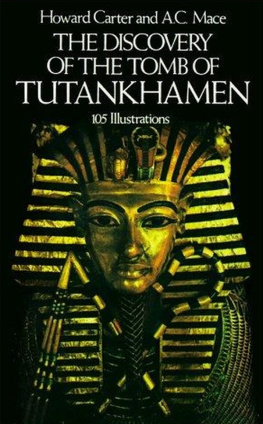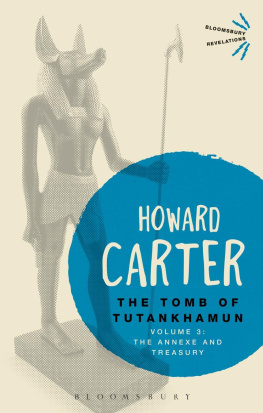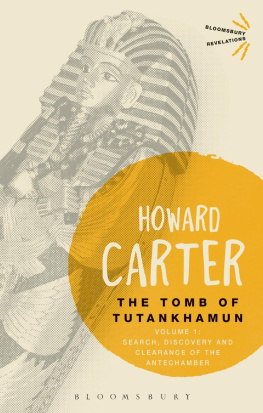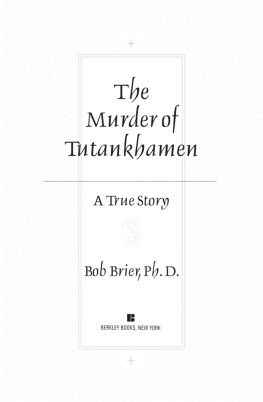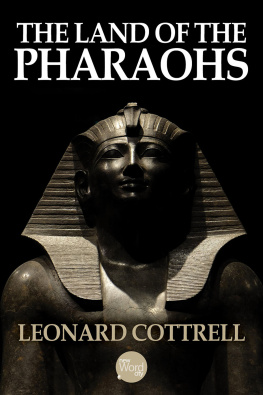Howard Carter - The Discovery of the Tomb of Tutankhamen
Here you can read online Howard Carter - The Discovery of the Tomb of Tutankhamen full text of the book (entire story) in english for free. Download pdf and epub, get meaning, cover and reviews about this ebook. year: 2013, publisher: Dover Publications, genre: Detective and thriller. Description of the work, (preface) as well as reviews are available. Best literature library LitArk.com created for fans of good reading and offers a wide selection of genres:
Romance novel
Science fiction
Adventure
Detective
Science
History
Home and family
Prose
Art
Politics
Computer
Non-fiction
Religion
Business
Children
Humor
Choose a favorite category and find really read worthwhile books. Enjoy immersion in the world of imagination, feel the emotions of the characters or learn something new for yourself, make an fascinating discovery.
- Book:The Discovery of the Tomb of Tutankhamen
- Author:
- Publisher:Dover Publications
- Genre:
- Year:2013
- Rating:3 / 5
- Favourites:Add to favourites
- Your mark:
- 60
- 1
- 2
- 3
- 4
- 5
The Discovery of the Tomb of Tutankhamen: summary, description and annotation
We offer to read an annotation, description, summary or preface (depends on what the author of the book "The Discovery of the Tomb of Tutankhamen" wrote himself). If you haven't found the necessary information about the book — write in the comments, we will try to find it.
The Discovery of the Tomb of Tutankhamen — read online for free the complete book (whole text) full work
Below is the text of the book, divided by pages. System saving the place of the last page read, allows you to conveniently read the book "The Discovery of the Tomb of Tutankhamen" online for free, without having to search again every time where you left off. Put a bookmark, and you can go to the page where you finished reading at any time.
Font size:
Interval:
Bookmark:
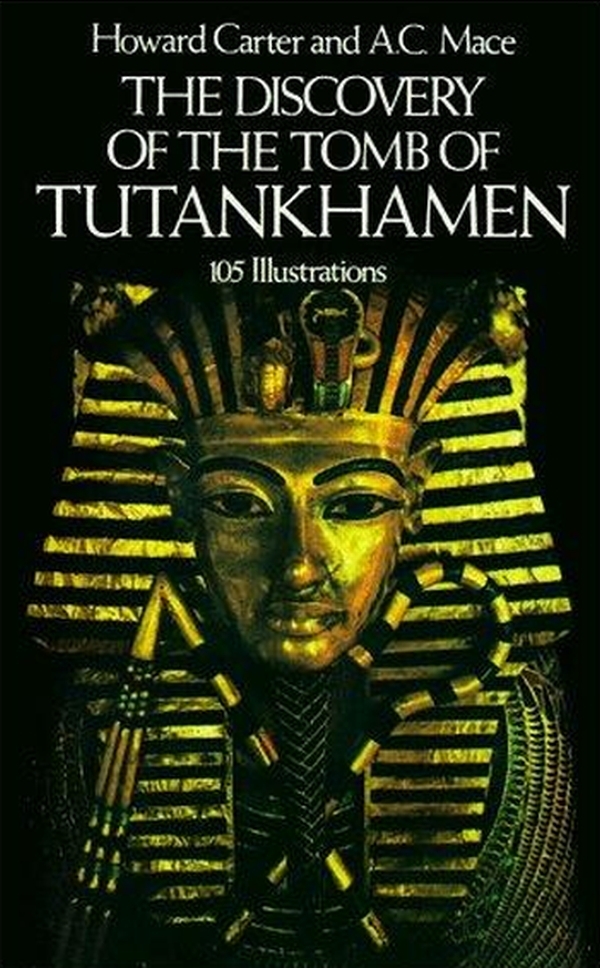
AMULETS AND SUPERSTITIONS, E. A. Wallis Budge. (23573-4)
BUDGES EGYPT: A CLASSIC 19TH-CENTURY TRAVEL GUIDE, E. A. Wallis Budge. (41721-2)
THE DIVINE ORIGIN OF THE CRAFT OF THE HERBALIST, E. A. Wallis Budge. (29169-3)
THE DWELLERS ON THE NILE, E. A. Wallis Budge. (23501-7)
THE EGYPTIAN BOOK OF THE DEAD, E. A. Wallis Budge. (21866-X)
THE EGYPTIAN HEAVEN AND HELL, E. A. Wallis Budge. (29368-8)
EGYPTIAN HIEROGLYPHIC DICTIONARY, E. A. Wallis Budge. (23615-3, 23616-1) Two-volume set
AN EGYPTIAN HIEROGLYPHIC READING BOOK FOR BEGINNERS, E. A. Wallis Budge. (27486-1)
EGYPTIAN IDEAS OF THE AFTERLIFE, E. A. Wallis Budge. (28464-6)
EGYPTIAN LANGUAGE: EASY LESSONS IN EGYPTIAN HIEROGLYPHS, E. A. Wallis Budge. (Not available in United Kingdom) (21394-3)
EGYPTIAN MAGIC, E. A. Wallis Budge. (22681-6)
FROM FETISH TO GOD IN ANCIENT EGYPT, E. A. Wallis Budge. (25803-3)
THE GODS OF THE EGYPTIANS, E. A. Wallis Budge. (22055-9, 22056-7) Two-volume set
A HIEROGLYPHIC VOCABULARY TO THE BOOK OF THE DEAD, E. A. Wallis Budge. (26724-5)
AN INTRODUCTION TO ANCIENT EGYPTIAN LITERATURE, E. A. Wallis Budge. (29502-8)
LEGENDS OF THE EGYPTIAN GODS, E. A. Wallis Budge. (28022-5)
THE LITURGY OF FUNERARY OFFERINGS, E. A. Wallis Budge. (28335-6)
THE MUMMY, E. A. Wallis Budge. (25928-5)
OSIRIS AND THE EGYPTIAN RESURRECTION, E. A. Wallis Budge. (22780-4, 22781-2) Two-volume set
THE ROSETTA STONE, E. A. Wallis Budge. (26163-8)
TUTANKHAMEN: AMENISM, ATENISM AND EGYPTIAN MONOTHEISM/WITH HIEROGLYPHIC TEXTS OF HYMMS TO AMEN AND ATEN, E. A. Wallis Budge. (26950-7)
THE DISCOVERY OF THE TOMB OF TUTANKHAMEN, Howard Carter and A. C. Mace. (23500-9)
ANCIENT EGYPTIAN CONSTRUCTION AND ARCHITECTURE, Somers Clarke and R. Engelbach. (26485-8)
ANCIENT EGYPTIAN POETRY AND PROSE, Adolf Erman. (28767-X)
LIFE IN ANCIENT EGYPT, Adolf Erman. (22632-8)
ANCIENT EGYPTIAN RELIGION: AN INTERPRETATION, Henri Frankfort. (41138-9)
THE LEYDEN PAPYRUS: AN EGYPTIAN MAGICAL BOOK, F. Griffith and Herbert Thompson (eds.). (22994-7)
ANCIENT EGYPTIAN DANCES, Irena Lexov. (40906-6)
ANCIENT EGYPTIAN MATERIALS AND INDUSTRIES, A. Lucas and J. Harris. (Available in U.S. only) (40446-3)
THE NILE AND EGYPTIAN CIVILIZATION, Alexandre Moret. (42009-4)
EGYPTIAN TEMPLES, Margaret A. Murray. (42255-0)
LEGENDS OF ANCIENT EGYPT, Margaret A. Murray. (41137-0)
EGYPTIAN SCARABS, Percy E. Newberry. (41959-2)
EGYPTIAN DECORATIVE ART, W. M. Flinders Petrie (ed.). (40907-4)
EGYPTIAN TALES, W. M. Flinders Petrie (ed.). (40908-2)
EGYPTIAN HIEROGLYPHICS: How TO READ AND WRITE THEM, Stephane Rossini. (Available in U.S. and Canada only) (26013-5)
ANCIENT EGYPTIAN MYTHS AND LEGENDS, Lewis Spence. (26525-0)
ANCIENT EGYPT, ITS CULTURE AND HISTORY, J. E. Manchip White. (22548-8)
ANCIENT EGYPTIAN DESIGNS FOR ARTISTS AND CRAFTSPEOPLE, Eva Wilson. (Not available in United Kingdom or Egypt) (25339-2)

THE LATE EARL OF CARNARVON.
From a Photograph by F. J. Mortimer, F.R.P.S.
Copyright 1977 by Dover Publications, Inc.
All rights reserved under Pan American and International Copyright Conventions.
9780486141824
This Dover edition, first published in 1977, is an unabridged republication of Volume I of the work The Tomb of Tut Ankh Amen Discovered by the Late Earl of Carnarvon and Howard Carter, originally published by Cassell and Company, Ltd, London, 1923 (subsequent volumes were published in 1927 and 1933). A new Introduction has been specially written for the present edition by Jon Manchip White.
International Standard Book Number:
0-486-23500-9
Library of Congress Catalog Card Number:
77-71042
Manufactured in the United States of America
Dover Publications, Inc., 31 East 2nd Street, Mineola, N.Y 11501
Dedcaton
With the full sympathy of my collaborator, Mr. Mace, I dedicate this account of the discovery of the tomb of Tut ankh Amen to the memory of my beloved friend and colleague
LORD CARNARVON
who died in the hour of his triumph. But for his untiring generosity and constant encouragement our labours could never have been crowned with success. His judgment in ancient art has rarely been equalled. His efforts, which have done so much to extend our knowledge of Egyptology, will ever be honoured in history, and by me his memory will always be cherished.
W HEN Howard Carters workmen pointed out to him the first step beneath the debris of a workmans hut, on November 4, 1922, he was on the threshold of the most spectacular discovery ever recorded in the annals of archaeology.
A professional excavator like Carter spends most of his life on dusty sites, in ungrateful corners of the world, clearing away mountains of earth and rubbish, trying to unravel the meaning of the broken and battered relics that come to light. This patient work is of absorbing interest to the excavator and to the specialists who will read his report in a learned journal, but it is of little interest to the public at large. Yet sometimes, capriciously, Fate elects to reward one of this persevering band with a discovery so glorious, so glittering, so apocalyptic, that our neglected ancestors suddenly spring to life in their full grandeur, and the whole world sits up and takes notice. This is what happened to Carter: he received a privilege, a blessing, a supernatural benediction, a crown of immortalitybut also, as we shall see, a blessing not unmixed with frustration and woe.
Splendid discoveries had been made in Egypt for a full century before Carters exploitwhich was why the country had long been the happy hunting ground of archaeologists and treasure-seekers. Statues, friezes and beautiful minor antiquities had emerged in plenty, and single discoveries had been interspersed with rich caches that had attracted the attention of educated people all over the globe. Mariette, the doyen of Egyptologists, had brought back to his newly established Cairo Museum impressive assemblages of objects; Brugsch and Loret had retrieved the actual bodies of some of the greatest pharaohs from pathetic hiding places at Kurna and Luxor; Petrie and Brunton had recovered an exquisite collection of Middle Kingdom jewellery at Lahun. In our own century, even after Carters stunning activities, wonderful though less heralded discoveries continued to be made. In 1925 Reisner stumbled on the only intact tomb chamber of the Old Kingdom, containing the personal furniture and adornments of Queen Hetep-heres, mother of Cheops and wife of Snofru; and as recently as 1940 Montet unearthed at Tanis, in the Delta, the mummy and funerary equipment of King Psusennes I of the Twenty-first Dynasty, which included a gold mask almost as striking as those of Tutankhamun.
These discoveries, exciting as they were, have been dimmed in popular imagination by Carters achievement, which recreated not merely a tiny fragment but an entire panorama of a vanished society. One speaks of Carters achievement, but, of course, other persons deserve their share of the credit. First, perhaps, we should recall how royalty and aristocracy are placed at the head of the cast list in Shakespeare, and begin with the figure of Carters patron, the fifth Earl of Carnarvon. It was the financial and moral support provided by this amiable nobleman that made the whole astonishing course of events possible.
Font size:
Interval:
Bookmark:
Similar books «The Discovery of the Tomb of Tutankhamen»
Look at similar books to The Discovery of the Tomb of Tutankhamen. We have selected literature similar in name and meaning in the hope of providing readers with more options to find new, interesting, not yet read works.
Discussion, reviews of the book The Discovery of the Tomb of Tutankhamen and just readers' own opinions. Leave your comments, write what you think about the work, its meaning or the main characters. Specify what exactly you liked and what you didn't like, and why you think so.

